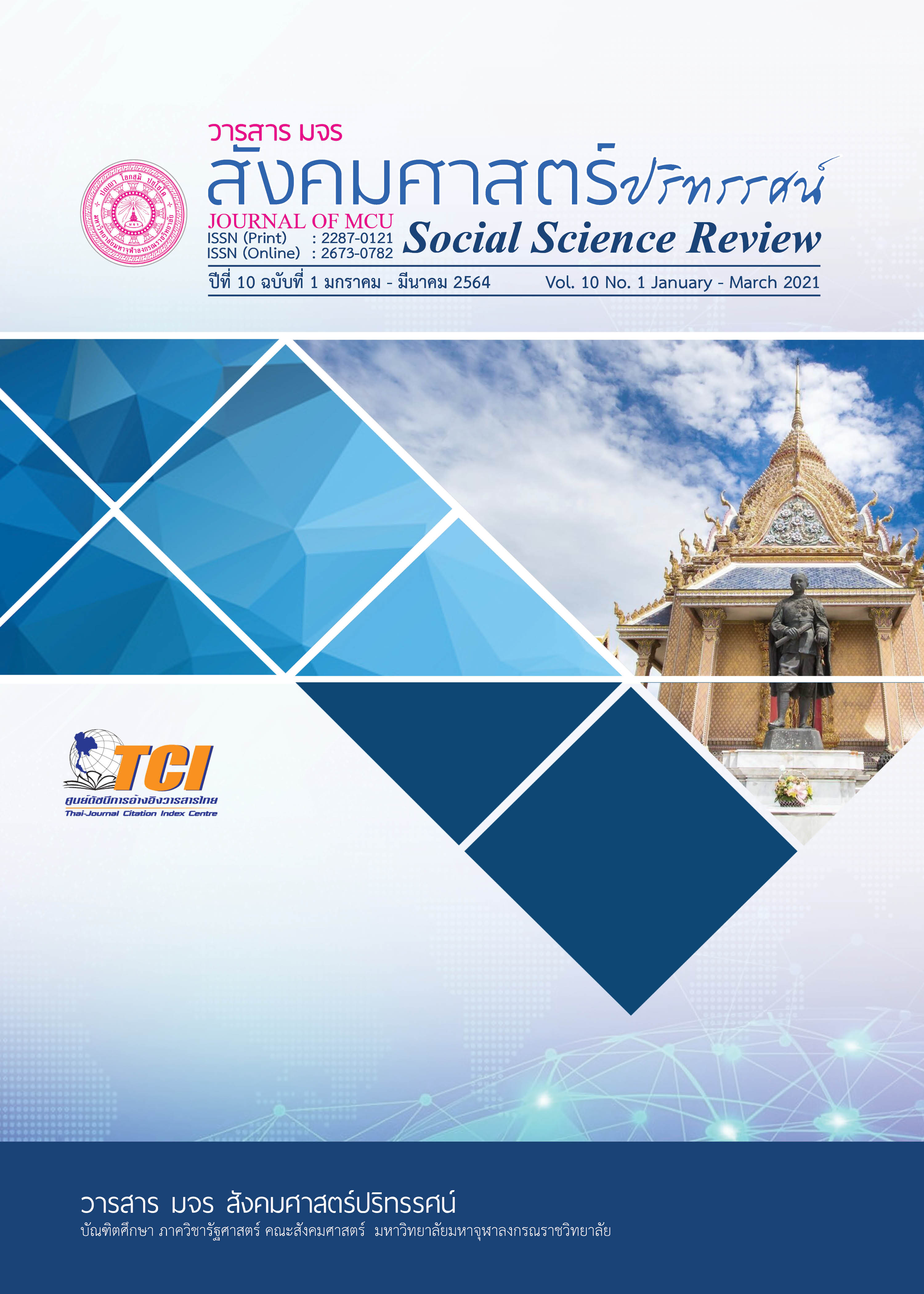การนำหลักพุทธธรรมมาใช้ในการบริหารทรัพยากรมนุษย์ขององค์กร
คำสำคัญ:
การบริหารทรัพยากรมนุษย์, องค์กร, หลักพุทธธรรมบทคัดย่อ
บทความวิชาการนี้มุ่งเน้นนำนเสนอเรื่อง 1.หลักการบริหารทรัพยากรมนุษย์ 2. แนวคิดเกี่ยวกับหลักสังคหวัตถุ 4 3. การประยุกต์หลักสังคหวัตถุ 4. มาใช้ในการบริหารทรัพยากรมนุษย์
5.องค์ความรู้ “การบริหารงานบุคคล” หรือ“การบริหาทรัพยากรมนุษย์” (Human Resource Management: HRM) ซึ่งเป็นที่รู้จัก และยอมรับกันอย่างกว้างขวางในการบริหารงานปัจจุบัน โลกของธุรกิจปัจจุบันมีความเจริญเติบโตและขยายตัวมากขึ้น แนวความคิดในด้านการบริหารงานบุคคลจึงจำเป็นต้องมีการขยายและพัฒนาให้สอดคล้องกับการเปลี่ยนแปลงดังกล่าว ทำให้นักวิชาการส่วนใหญ่ไม่ได้มองว่าบุคลากรในองค์การเป็นแค่เพียงผู้รับคำสั่ง แต่ในบทบาทใหม่บุคลากรมีฐานะเป็นทรัพยากรขององค์การ ที่เรียกว่า “ทุนมนุษย์” ซึ่งมีส่วนร่วมส่งเสริมและสนับสนุนให้งานต่าง ๆ ขององค์การเนินไปได้อย่างมีประสิทธิภาพและประสิทธิผล ประสบความสำเร็จ ด้วยเหตุผลนี้เองจึงทำให้การบริหารทรัพยากรมนุษย์เป็นที่ยอมรับและมีความสำคัญต่อองค์กร และในขณะเดียวกันในทางพระพุทธศาสนาวางหลักในการบริหารที่สามารถนำมาประยุกต์ใช้ได้อย่างเหมาะสมในการพัฒนา ทรัพยากรมนุษย์ โดยหลักพุทธธรรมที่เหมาะสมสอดคล้องคือหลัก สังคหวัตถุ 4 ซึ่งเป็นธรรมพัฒนาบุคลากร เป็นหลักในการบริหารคนให้เป็นอันเดียวกันเพื่อการปฏิบัติงานให้บรรลุเป้าหมายอย่างมีประสิทธิภาพและประสิทธิผล
เอกสารอ้างอิง
กัลยารัตน์ ธีระธนชัยกุล. (2557). การบริหารทรัพยากรมนุษย์. กรุงเทพฯ: ส.เอเชียเพรส.
ธัญญา ผลอนันต์. (2549). การมุ่งเน้นทรัพยากรบุคคล: แนวทางสร้างความพึงพอใจแก่พนักงาน (พิมพ์ครั้งที่ 4). กรุงเทพฯ: บริษัท อินโนกราฟฟิกส์จำกัด.
ธำรงศักดิ์ คงคาสวัสดิ์. (2550). ทุนมนุษย์การกำหนดตัวชี้วัดเพื่อการพัฒนา. กรุงเทพฯ: สำนักพิมพ์สมาคมส่งเสริมเทคโนโลยี (ไทย – ญี่ปุ่น).
บุญทัน ดอกไธสง. (2551). การจัดการทุนมนุษย์. กรุงเทพฯ: สำนักพิมพ์พิมพ์ตะวัน.
พระธรรมโกศาจารย์ (ประยูร ธมฺมจิตฺโต). (2549). พุทธวิธีการบริหาร . กรุงเทพฯ: โรงพิมพ์มหาจุฬาลงกรณราชวิทยาลัย.
พิพัฒน์ ก้องกิจกุล. (2549). Balanced scorecard กับการเน้นกลยุทธ์ (พิมพ์ครั้งที่ 2). กรุงเทพฯ: บริษัท เอ็กซ์สเปอร์เน็ท จำกัด.
พิมลพรรณ เชื้อบางแก้ว. (2550). การบริหารทรัพยากรมนุษย์ (พิมพ์ครั้งที่ 6). ปทุมธานี: สำนักพิมพ์มหาวิทยาลัยกรุงเทพ.
มหาจุฬาลงกรณราชวิทยาลัย. (2539). พระไตรปิฎกฉบับภาษาไทย ฉบับมหาจุฬาลงกรณราชวิทยาลัย. กรุงเทพฯ: โรงพิมพ์มหาจุฬาลงกรณราชวิทยาลัย.
วิลาวรรณ รพีพิศาล. (2554). การบริหารทรัพยากรมนุษย์ (พิมพ์ครั้งที่ 3). กรุงเทพฯ: โรงพิมพ์วิจิตรหัตถกร.
สมบัติ นามบุรี. (2562). โมเดลความสัมพันธ์เชิงสาเหตุแบบพุทธบูรณาการของ ภาวะผู้นำการเปลี่ยนแปลงในศตวรรษที่ 21 ของผู้บริหารการท่องเที่ยวแห่งประเทศไทย. วารสารบัณฑิตศึกษามหาจุฬาขอนแก่น, 6(4),803-822.
สัมฤทธิ์ ยศสมศักดิ์. (2549). การบริหารทรัพยากรมนุษย์. กรุงเทพฯ: ห้างหุ้นส่วนจำกัด เอ็ม. ที. เพรส.
ดาวน์โหลด
เผยแพร่แล้ว
รูปแบบการอ้างอิง
ฉบับ
ประเภทบทความ
สัญญาอนุญาต
ลิขสิทธิ์ (c) 2021 วารสาร มจร สังคมศาสตร์ปริทรรศน์

อนุญาตภายใต้เงื่อนไข Creative Commons Attribution-NonCommercial-NoDerivatives 4.0 International License.
เพื่อให้เป็นไปตามกฎหมายลิขสิทธิ์ ผู้นิพนธ์ทุกท่านต้องลงลายมือชื่อในแบบฟอร์มใบมอบลิขสิทธิ์บทความให้แก่วารสารฯ พร้อมกับบทความต้นฉบับที่ได้แก้ไขครั้งสุดท้าย นอกจากนี้ ผู้นิพนธ์ทุกท่านต้องยืนยันว่าบทความต้นฉบับที่ส่งมาตีพิมพ์นั้น ได้ส่งมาตีพิมพ์เฉพาะในวารสาร มจร สังคมศาสตร์ปริทรรศน์ เพียงแห่งเดียวเท่านั้น หากมีการใช้ภาพหรือตารางหรือเนื้อหาอื่นๆ ของผู้นิพนธ์อื่นที่ปรากฏในสิ่งตีพิมพ์อื่นมาแล้ว ผู้นิพนธ์ต้องขออนุญาตเจ้าของลิขสิทธิ์ก่อน พร้อมทั้งแสดงหนังสือที่ได้รับการยินยอมต่อบรรณาธิการ ก่อนที่บทความจะได้รับการตีพิมพ์ หากไม่เป็นไปตามข้อกำหนดเบื้องต้น ทางวารสารจะถอดบทความของท่านออกโดยไม่มีข้อยกเว้นใดๆ ทั้งสิ้น





